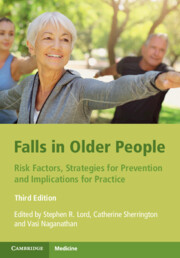Book contents
- Falls in Older People
- Falls in Older People
- Copyright page
- Contents
- Preface
- Contributors
- Part I Epidemiology and Risk Factors for Falls
- 1 Epidemiology of Falls and Fall-Related Injuries
- 2 Postural Stability and Falls
- 3 Gait Characteristics and Falls
- 4 Sensory and Neuromuscular Risk Factors for Falls
- 5 Biomechanics of Balance and Falling
- 6 Foot Problems, Footwear, and Falls
- 7 Brain Function and Falls
- 8 Impaired Cognition and Falls
- 9 The Psychology of Fall Risk: Fear, Anxiety, Depression, and Balance Confidence
- 10 Medical Risk Factors for Falls
- 11 Medications as Risk Factors for Falls
- 12 Environmental Risk Factors for Falls
- 13 Fall Detection and Risk Assessment with New Technologies
- 14 Fall Risk Screening and Assessment
- 15 The Relative Importance of Fall Risk Factors: Analysis and Summary
- Part II Strategies for Prevention
- Part III Implications for Practice
- Index
- References
13 - Fall Detection and Risk Assessment with New Technologies
from Part I - Epidemiology and Risk Factors for Falls
Published online by Cambridge University Press: 04 November 2021
- Falls in Older People
- Falls in Older People
- Copyright page
- Contents
- Preface
- Contributors
- Part I Epidemiology and Risk Factors for Falls
- 1 Epidemiology of Falls and Fall-Related Injuries
- 2 Postural Stability and Falls
- 3 Gait Characteristics and Falls
- 4 Sensory and Neuromuscular Risk Factors for Falls
- 5 Biomechanics of Balance and Falling
- 6 Foot Problems, Footwear, and Falls
- 7 Brain Function and Falls
- 8 Impaired Cognition and Falls
- 9 The Psychology of Fall Risk: Fear, Anxiety, Depression, and Balance Confidence
- 10 Medical Risk Factors for Falls
- 11 Medications as Risk Factors for Falls
- 12 Environmental Risk Factors for Falls
- 13 Fall Detection and Risk Assessment with New Technologies
- 14 Fall Risk Screening and Assessment
- 15 The Relative Importance of Fall Risk Factors: Analysis and Summary
- Part II Strategies for Prevention
- Part III Implications for Practice
- Index
- References
Summary
Recent advances in technology allow for remote fall detection and risk assessment in the home environment. Technology has the potential to contribute to the prevention of falls, and associated physical and psychological trauma, and thereby improve the lives of older people. The aim of this chapter is to provide a comprehensive overview of the fields of remote fall detection and risk assessment with a focus on wearable technology and its clinical utility.
- Type
- Chapter
- Information
- Falls in Older PeopleRisk Factors, Strategies for Prevention and Implications for Practice, pp. 211 - 226Publisher: Cambridge University PressPrint publication year: 2021



